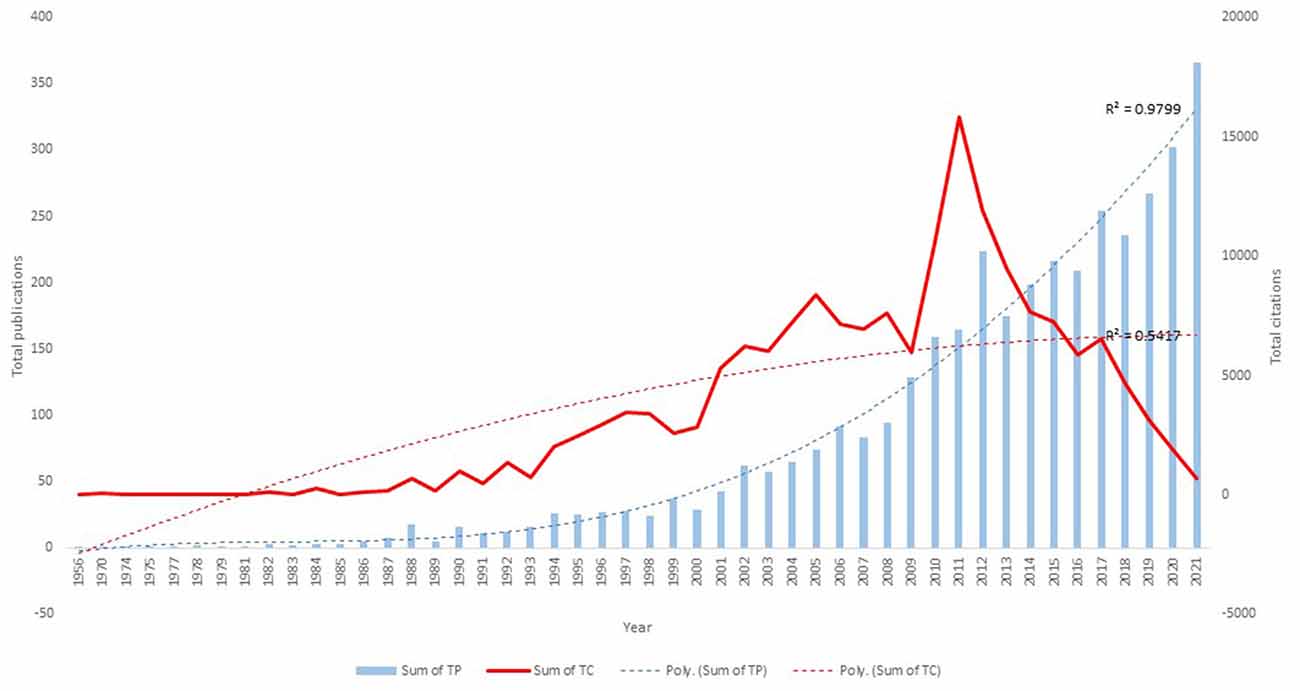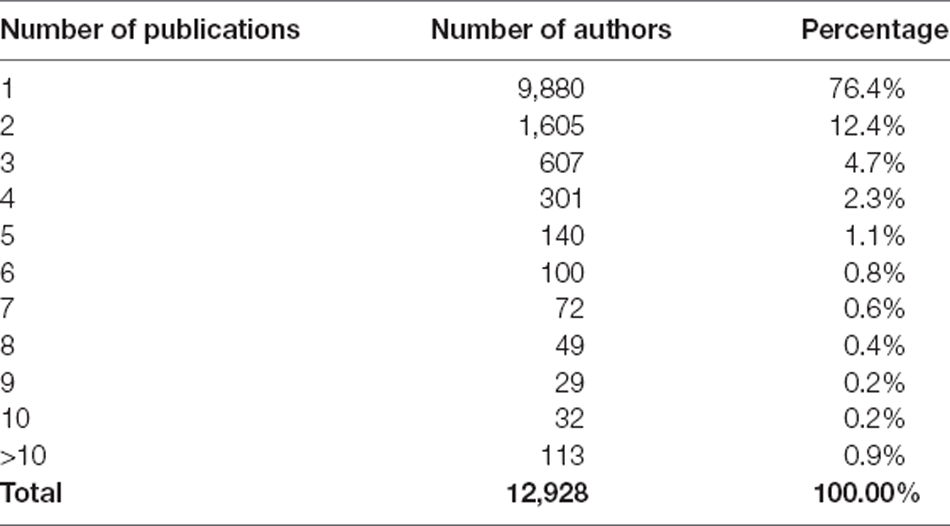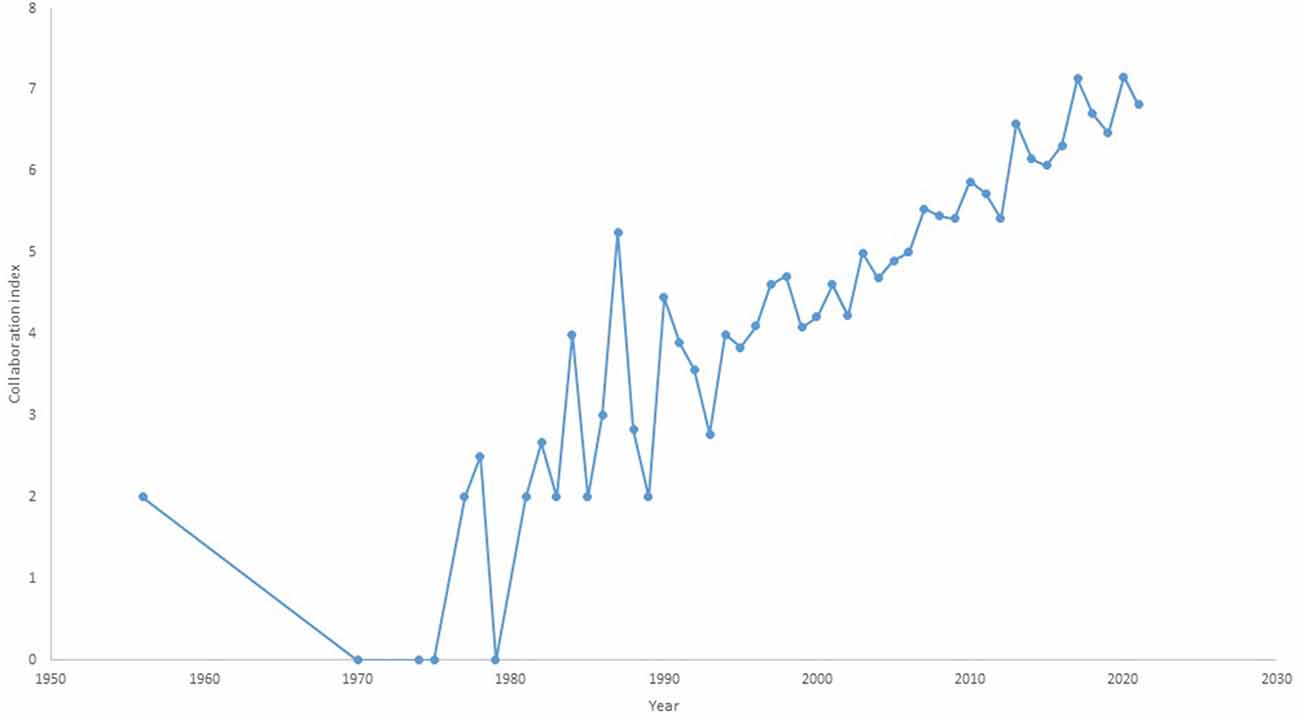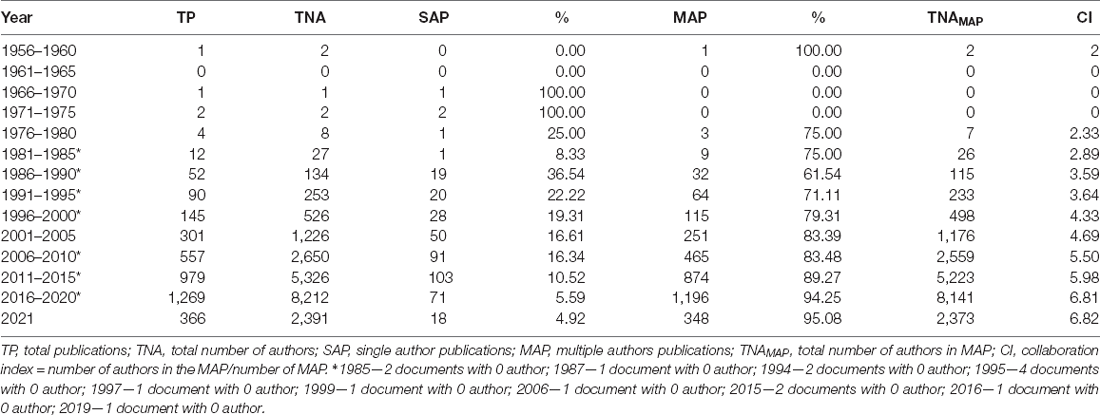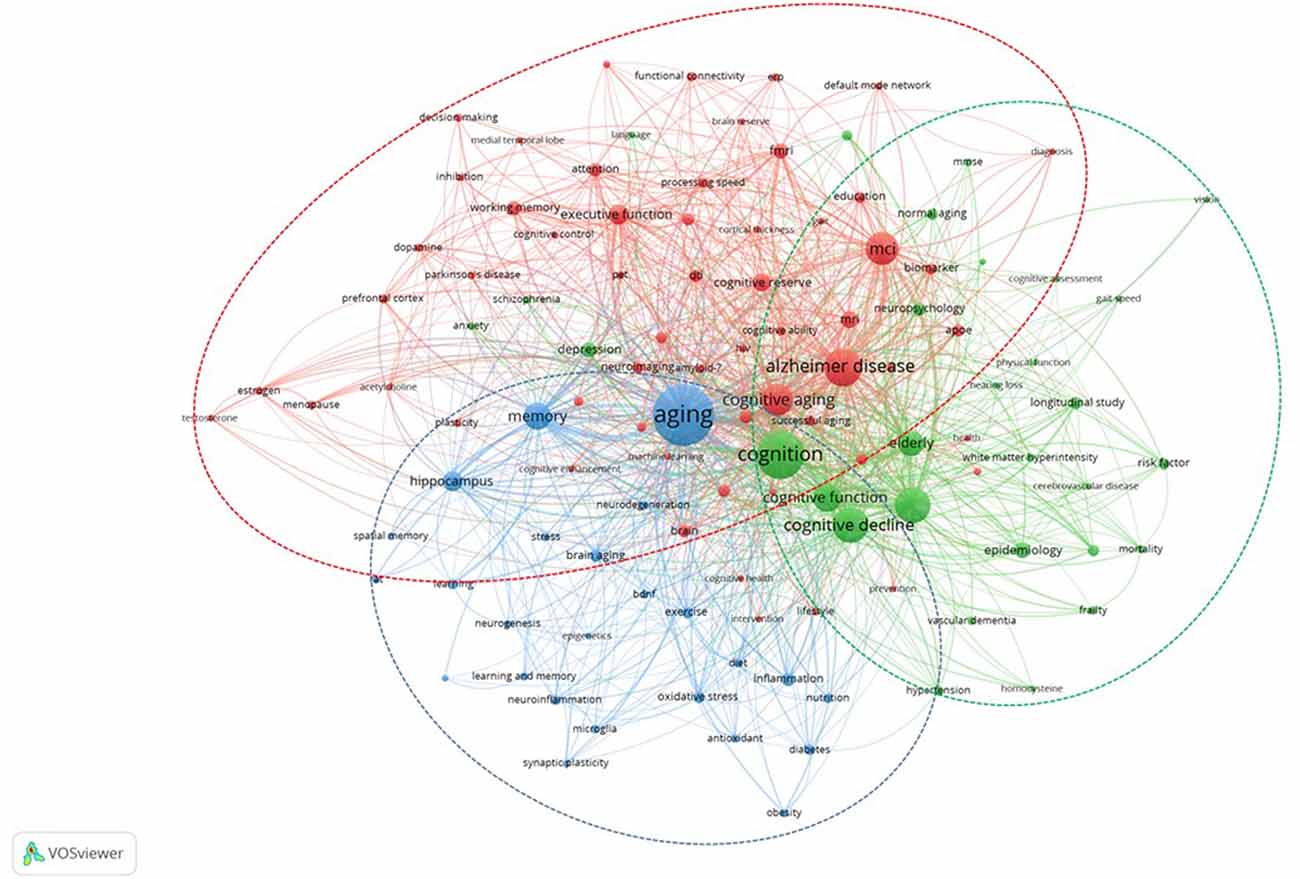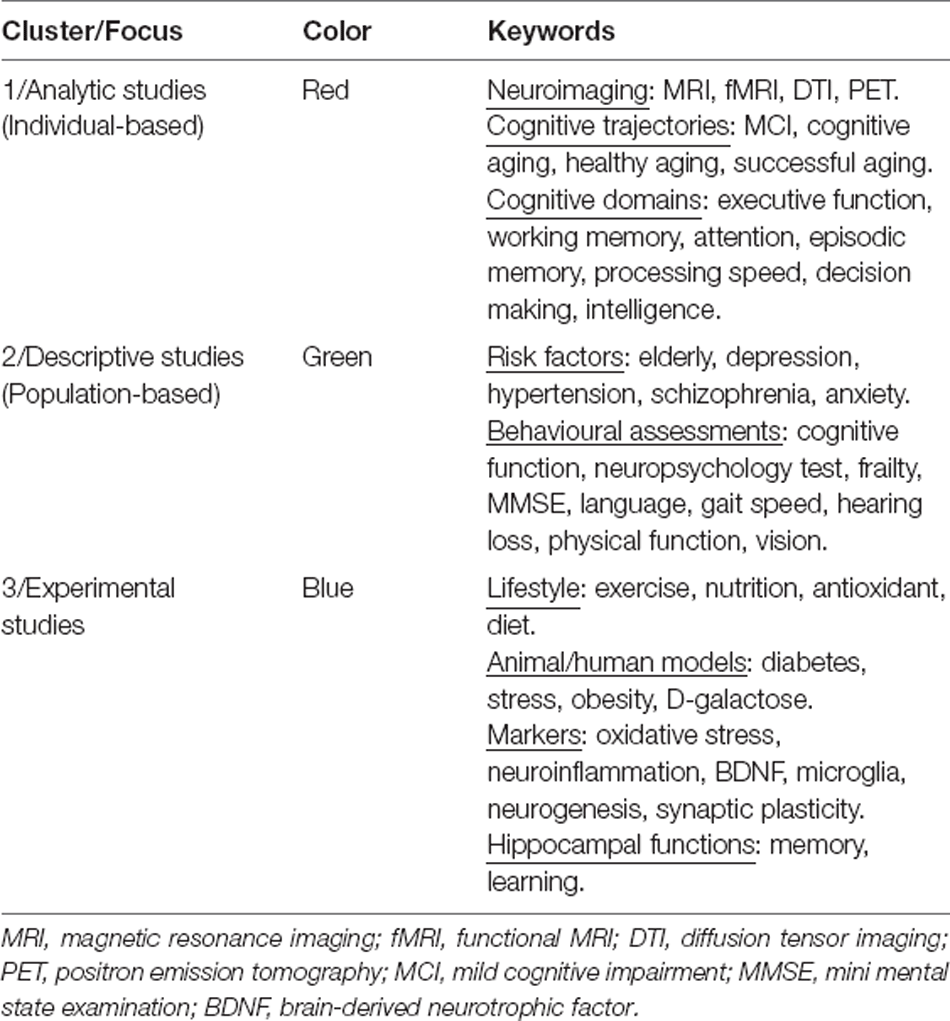- 1School of Medical Sciences, Universiti Sains Malaysia, Kota Bharu, Malaysia
- 2Department of Basic Medical Sciences, Kulliyyah of Medicine, International Islamic University Malaysia, Kuantan, Malaysia
- 3Department of Health Information Management, Universitas Indonesia Maju, Jakarta, Indonesia
- 4Tunku Puteri Intan Safinaz School of Accountancy, Universiti Utara Malaysia, Sintok, Malaysia
Objectives: This study aimed to profile the cognitive aging research landscape from 1956 to 2021.
Methods: A total of 3,779 documents were retrieved from the Scopus database for the bibliometric analysis and network visualization. By comparing each keyword’s overall connection strength (centrality), frequency (density), and average year of publication (novelty) to the calculated median values acquired from the overlay view of the VOSviewer map, the enhanced strategic diagrams (ESDs) were constructed.
Results: The findings showed an increasing trend in the number of publications. The United States leads the contributing countries in cognitive aging research. The scientific productivity pattern obeyed Lotka’s law. The most productive researcher was Deary, I. J., with the highest number of publications. The collaborative index showed an increasing trend from 1980 onwards. Frontiers in Aging Neuroscience is the most prestigious journal in the field of cognitive aging research. In Bradford core journals zone 1, the top 10 core journals of cognitive aging research provided more than half of the total articles (697, or 55.36 percent).
Conclusions: For the next decades, the trending topics in cognitive aging research include neuropsychological assessment, functional connectivity, human immunodeficiency virus (HIV), decision-making, gender, compensation, default mode network, learning and memory, brain-derived neurotrophic factor (BDNF), obesity, D-galactose, epigenetics, frailty, mortality, mini-mental state examination (MMSE), anxiety, and gait speed.
Background
The scientific literature has long demonstrated cognitive change as a natural part of aging. The dynamic and variable longitudinal changes in cognitive function that occur inherently during the aging process are referred to as cognitive aging (Harada et al., 2013). However, those who maintain their cognitive function at high levels, even with advancing age, are categorized as successful cognitive aging (Daffner, 2010).
The cascade model of cognitive aging suggested by Birren and Cunningham (1985) emphasized a life course approach to cognitive aging and cognitive performance. According to the model, primary aging is characterized by a steady deterioration in mental function, which is often accompanied by problems with memory (particularly new learning and retention), information processing, language, and other cognitive skills. Secondary aging refers to a loss of fluid and crystallized cognitive capacities caused by a disease process such as dementia, whereas tertiary aging refers to impairments in cognitive function caused by total biological devitalization of the organism before death (Birren and Cunningham, 1985).
Brayne and Calloway (1988), on the other hand, depict cognitive decline as a continuum, ranging from normal and successful aging to moderate cognitive impairment and dementia. This model depicts a general downward trend in all elements of cognitive ability, regardless of the competing danger of neuropathological alterations like dementia. However, Krivanek et al. (2021) suggested a new model of cognitive decline that depicts the progression of cognitive decline. In people with neurodegenerative diseases, this theoretical curve would shift to the left. On the other hand, boosting cognitive or brain reserve would shift this theoretical curve to the right, allowing patients to reach this threshold later in life (Figure 1).
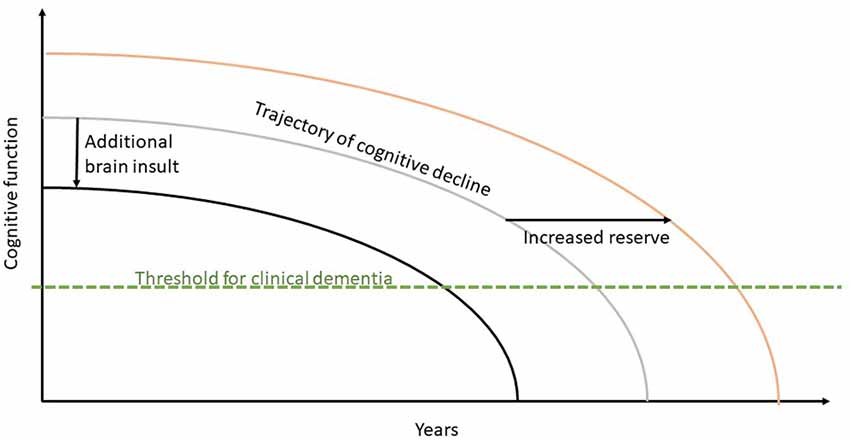
Figure 1. Cognitive decline model. Figure adapted from Krivanek et al. (2021); copyright (2021) with permission from IOS Press.
Earlier neurocognitive models, which blend behavioral and neurological evidence to develop a conceptual model of cognitive aging, are based on neural compensation. These models, such as the Hemispheric Asymmetry Reduction in Older Adults (HAROLD; Cabeza, 2002), the Compensation-Related Utilization of Neural Circuits Hypothesis (CRUNCH, Reuter-Lorenz and Cappell, 2008), the Posterior-Anterior Shift in Aging (PASA; Davis et al., 2008), and the Scaffolding Theory of Aging And Cognition (STAC and STAC-r; Park and Reuter-Lorenz, 2009; Reuter-Lorenz and Park, 2014), postulate that older adults can perform as well as young adults on cognitive tasks depending on their capacity to recruit additional neural networks. These models, however, were unable to fully explain the cognitive deterioration that happens with healthy aging. Ebaid and Crewther (2020) then offered a theory of cognitive aging based on a system biology approach that combines the sensory deprivation hypothesis, the information degradation hypothesis, and the common-cause hypothesis. The theory stressed the significance of including all of the biological changes that frequently occur at a later age (Ebaid and Crewther, 2020).
Many studies on cognitive aging including its theories have been conducted in the past but only a few have kept track of the literature. The impact of literature on future research could be determined by bibliometric analysis, which is a quantitative analysis of publication metadata. The application of bibliometric approaches in the scientific and professional community has progressed much beyond the basic concept of simple lists of scientific production or citation indexing, and there is a wide range of applications across disciplines (Ellegaard, 2018). This is owing to advancements in bibliometric software such as VOSviewer, Gephi, and Leximencer, as well as the availability and accessibility of scientific databases like Web of Science and Scopus (Donthu et al., 2021).
Previous bibliometric studies have investigated general aspects of aging, namely, aging or oldest age or geriatric (Lund and Wang, 2020; Gonzalez-Alcaide et al., 2021), healthy aging (Gu et al., 2019), aging in combination with other issues such as reception by the scientific community (Glänzel and Schoepflin, 1995), physical therapy (Arnal-GÓmez et al., 2020), geriatric nursing (Ghamgosar et al., 2021), mobile technologies (Tajudeen et al., 2022), safety in-home care (Cao et al., 2021), subjective well-being (Dominko and Verbič, 2019), and specific to aging policies in China (Nan et al., 2020). This bibliometric analysis and network visualization, on the other hand, was carried out to explore the literature on cognitive aging in the Scopus database. It aimed to answer the following research questions:
1. How far has cognitive aging research progressed in terms of publication?
2. What is the scientific productivity pattern in the field of cognitive aging research?
3. Who are the most productive authors in the field of cognitive aging research?
4. What is the present state of collaboration in the field of cognitive aging research?
5. What is the pattern of research on cognitive aging that is scattered?
6. What are the main areas of cognitive aging research?
Therefore, in the present study, we attempted to reveal the publishing trends, scientific productivity patterns, the most productive authors, collaboration status, research patterns across the sources, and the major areas of cognitive aging research.
Methods
Data Collection
This is a bibliometric study, which is a computer-assisted review procedure for identifying core research or authors, as well as their relationships by examining all publications related to a specific topic or field (De Bellis, 2009). The data for this study were retrieved and downloaded from the Scopus database on March 21, 2022. From 1956 to 2021, the search term “cogniti* AND ag*ing” in the article title was utilized. We included all the documents written in English from 1956 to 2021. We excluded the 2022 documents (n = 71), since the 2022 data is incomplete, and the erratum (n = 82) to avoid double counting. Finally, 3,779 documents were identified and downloaded for further analysis (Figure 2).
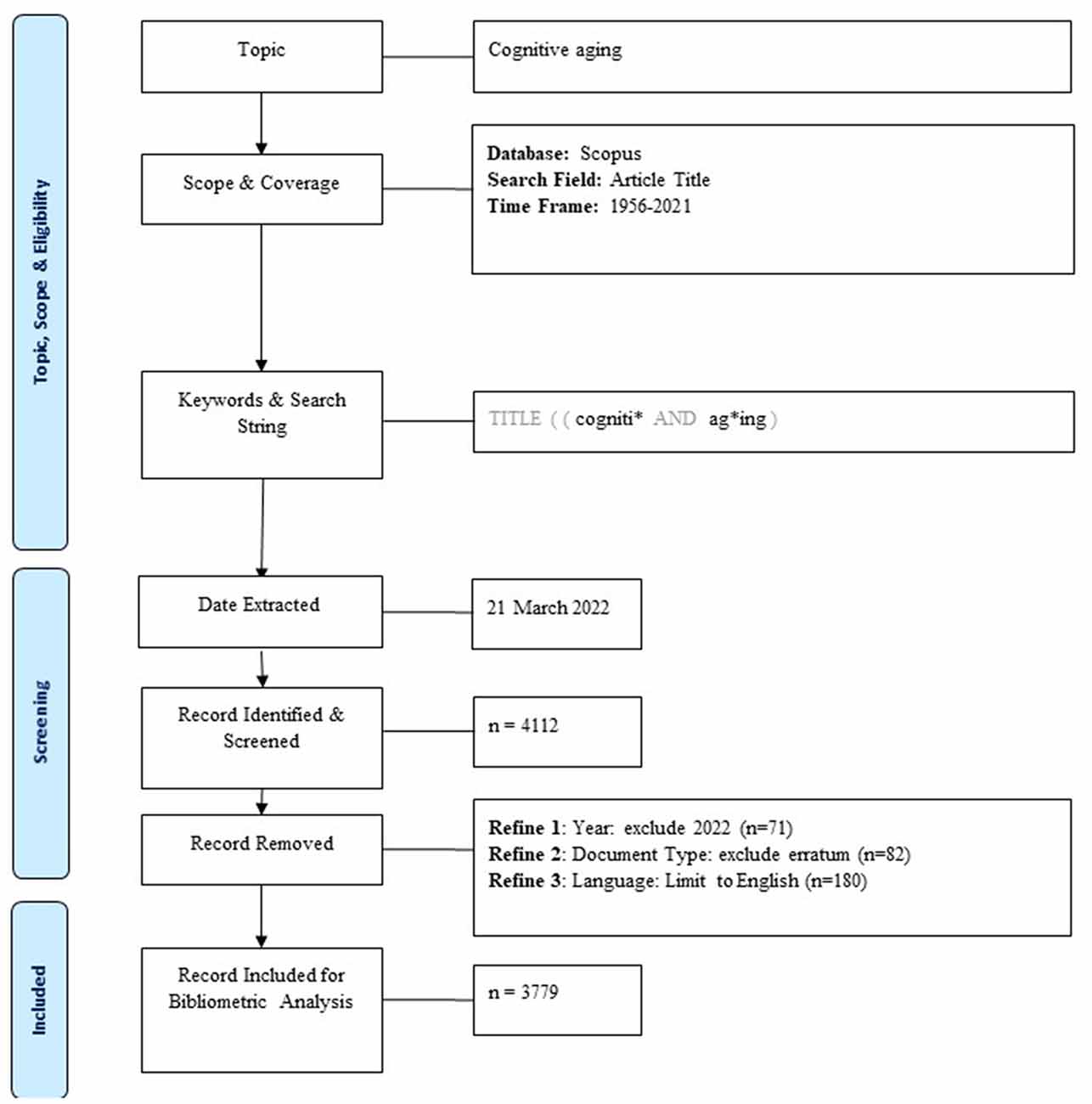
Figure 2. PRISMA flow chart of data inclusion and exclusion (Page et al., 2021).
Data Analysis
We have combined performance analysis and network analysis to answer our research objectives. The performance analysis, which includes citation- and publication-related metrics, was conducted using Harzing’s Publish or Perish (Harzing, 2007) and BibliometriX R package software (Aria and Cuccurullo, 2017). The author’s keywords were mapped using VOSviewer software (version 1.6.17), a popular tool with a simple graphic interface that can be used to create an author’s keyword co-occurrence map (Van Eck and Waltman, 2021). It allows for identifying significant research subjects and finding large research clusters related to cognitive aging.
Based on a study by Feng et al. (2021), we have created the improved enhanced strategic diagram (ESDs) with the x-axis representing centrality, the y-axis representing density, and the z-axis representing time on a three-dimensional plane. Centrality is a metric that measures the degree of interaction between networks (Cobo et al., 2011; Feng et al., 2021). A theme with a higher centrality score has more external connections to other themes (external strength) and hence has a bigger impact on the development and evolution of the research field (Cobo et al., 2011; Hansen et al., 2020; Feng et al., 2021). This study used the mean strength value of external links to other subjects, i.e., total link strength (TLS), to determine centrality. TLS values equal to or more than the calculated median value were regarded as high centrality, while those less than the median value were regarded as poor centrality.
The density of a topic, on the other hand, is used to determine the topic’s internal strength or degree of interaction within a network (Cobo et al., 2011; Feng et al., 2021). The density of the author’s keywords was determined in this study using co-occurrences. The median value was computed, and co-occurrence values equal to or higher than it was regarded as high density, while those below it were regarded as low density. The novelty of the study, on the other hand, is reflected by time (Feng et al., 2021), and the average publication year was employed in this study. In terms of novelty, the median value of the average publication year was determined, and average publication years equal to or greater than the median were regarded as novel and vice versa.
Results
This study analyzed the main bibliometric indicators to profile the research landscape on cognitive aging from 1956 to 2021.
Publication and Citation Trend
There were 3,779 publications on cognitive aging retrieved from the Scopus database for this study. The first publication, “The judgment of ambiguous stimuli as an index of cognitive functioning in aging”, was included in the analysis (Basowitz and Korchin, 1956). The number of publications related to cognitive aging remained in the single digits every year until 1987. The publication has been steadily expanding since then (Figure 3). Over the previous three decades, a rapid increase in publications has been reported (1991–2000: 236 or 6.22 percent; 2001–2010: 858 or 22.71 percent; 2011–2020: 2,247 or 59.48 percent). The trend line shows that the number of publications increases polynomially (R2 = 0.9799), which is greater than a linear increase. In terms of citations, the overall number of citations per year showed a steady increase and an inverse correlation after 2011. The trend line shows that total citations increase polynomially (R2 = 0.5417), indicating that citations are on an increasing trend, although in the last decade the increase has not been as high as in previous decades.
Geographical Distribution of the Publications
Table 1 shows the most productive countries based on the number of publications. The United States was the most prolific country and contributed almost half of the total publications. This was followed by the United Kingdom (n = 472 or 12.49%), Canada (n = 303 or 8.02%), Germany (n = 238 or 6.30%) and Australia (n = 219 or 5.80%). In terms of total citations, the United States had the lead in citations, followed by the United Kingdom, Canada, and Germany. However, France (10,963) surpassed Australia (8,432), Italy (5,062), and China (4,608).
Scientific Productivity Pattern
A total of 12,928 authors contributed to the publications of cognitive aging research. Table 2 lists the number of publications each author has contributed. The majority of the authors have only published once. Between 1956 and 2021, nearly a quarter of the authors contributed at least two articles on cognitive aging.
Most Productive Authors
The top 10 most productive authors are listed in Table 3. Based on the number of publications each had published, Deary, I.J., Petersen, R.C., and Brayne, C. were the three major contributing authors. However, Petersen, R.C. obtained the highest citations in terms of total citations, followed by Deary, I.J. and Brayne, C. The topmost cited article in cognitive aging co-authored by Petersen R.C. (Albert et al., 2011), may have contributed to this finding. H-index (Hirsch, 2005) is a measure of the broad impact of researchers’ scientific achievement, especially in sciences and medicine. All the highly productive authors had a value above 20, except for Brodaty, H. and Sachdev, P.S.
Collaboration Status
The collaboration status of cognitive aging research was measured using the collaboration indices as listed in Table 4. Only one published article related to cognitive aging between 1956 and 1965 and the total publications started to increase in the mid-1980s onwards and this could be explained by the progress in cognitive aging research worldwide (Anderson and Craik, 2017). Only 405 or 10.72% were single-authored documents. The majority of the articles published between 1956 and 2021 had multi-authored documents, indicating collaboration. The co-authorship of four researchers on average (mean CI = 4.42) resulted in these multi-authored publications as shown by the collaboration index (Figure 4).
Scattering Pattern of Research Work Across the Sources
The distribution of document sources was assessed using Bradford (1950) to establish the scattering pattern of research on cognitive aging. The decreasingly ordered document sources were divided into three zones, each of which had an average number of 1,260 documents. Table 5 shows that there were 32 Bradford’s core journals (Zone 1 or nucleus) with 1,259 articles, Zone 2 had 187 journals (1,275 articles), and Zone 3 had 965 journals (1,245 articles).
Table 6 shows the top 10 core journals of cognitive aging research, which contributed more than half of the total articles (697 or 55.36%) in zone 1. In terms of total citations, Psychology and Aging obtained the highest total citations with two articles ranking among the top 10 most cited (Baltes and Lindenberger, 1997; Bialystok et al., 2004), followed by Neurobiology of Aging, Journals of Gerontology Series B Psychological Sciences and Social Sciences, Frontiers in Aging Neuroscience, and Journal of the American Geriatrics Society. Most of the journals listed in the top 10 core sources were specific to aging research except for PLoS One, which covers many subject areas.
Main Topics of the Research on Cognitive Aging
The main topics of cognitive aging research were identified using a keyword co-occurrence analysis. Only 113 of the 5,258 keywords used by the author surpassed the minimum occurrence level of 13 (Figure 5). Analytical (individual-based), descriptive (population-based), and experimental studies are the three clusters that emerge from the map (Table 7).
The ESDs were created by comparing each keyword’s overall link strength (centrality), frequency (density), and average year of publication (novelty) to the derived median values obtained from the overlay view of the VOSviewer map. There are four different types of themes that can be determined based on the plane’s position (Cobo et al., 2011; Feng et al., 2021). The four themes in the novel publication year are depicted in Figure 6A. Emerging with high density (upper-left quadrant), emerging with low density (lower-left quadrant), core (upper-right quadrant), and interdisciplinary (lower-right quadrant) are the four categories (lower-right quadrant). Figure 6B depicts the four themes that existed in the old publication year: isolated (upper-left quadrant), obsolete (lower-left quadrant), mature (upper-right quadrant), and declining (lower-right quadrant).
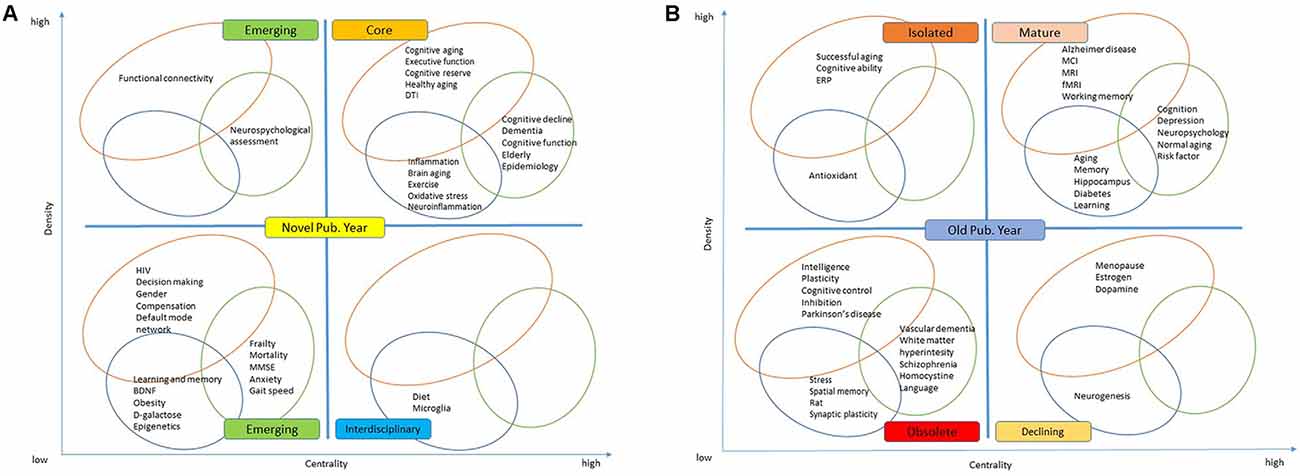
Figure 6. Enhanced strategic diagrams showing (A) emerging, core, and interdisciplinary in the novel publication year (B) isolated, mature, obsolete, and declining topics in the old publication year.
Discussion
The cognitive aging theory was first introduced by Welford and Birren in 1965 (Birren, 1965). Before 1965, cognitive aging research was descriptive, determining which areas of intellectual performance are impaired in older vs. younger persons (Anderson and Craik, 2017). Over the past three decades, the growing number of publications meant that research on cognitive aging was gaining traction around the world. This was in line with the findings on healthy aging and geriatric nursing research reported by Gu et al. (2019) and Ghamgosar et al. (2021), respectively. Furthermore, this continual increase in research has important clinical and intellectual implications, as it aids clinicians in better measuring, preventing, and treating cognitive aging by establishing individualized risk profiles connected to a personalized intervention strategy (Ryan et al., 2019). The total citations peaked in 2011, suggesting this to be the key year for the development of the field (Cao et al., 2021). Further investigation revealed that the National Institute on Aging-Association Alzheimer’s working groups on Alzheimer’s disease diagnostic criteria issued a set of recommendations for diagnosing mild cognitive impairment attributable to Alzheimer’s disease in 2011 (Albert et al., 2011).
The United States was the most prolific country followed by the United Kingdom, Canada, Germany, and Australia. The productivity of the top five countries was in line with the recent study conducted by Arnal-GÓmez et al. (2020). The authors suggested that productivity was related to the aging of their population, as shown by the positive correlation between productivity and the aged population. However, in terms of scientific productivity pattern, as the number of publications contributed increased, the number of authors declined. This was consistent with Lotka’s Law (Lotka, 1926), which stated that single-publication authors are far more likely to conduct subsequent research on similar research areas (Rowlands, 2005; Kushairi and Ahmi, 2021).
The collaboration index was on the rise, reflecting the growing complexity of multidisciplinary research and the increasing quantity and quality of the resultant publications in cognitive aging (Stallings et al., 2013). According to several studies, research conducted by larger groups is more influential and impactful (Crane, 1972; Goffman and Warren, 1980). Furthermore, articles co-authored by international collaborators receive more citations than articles co-authored by domestic collaborators, implying that internationally co-authored articles represent a larger segment of global science (Narin et al., 1991). Dutt and Nikam (2015), however, reported that publications from certain prolific countries and institutions emerging from domestic collaboration resulted in a higher impact than those from international collaboration.
Based on the keyword co-occurrence analysis, there are three main clusters. In the analytical (individual-based) studies cluster, the main keywords were grouped into: (i) neuroimaging which includes various modalities; (ii) cognitive trajectories that are related to the major study groups; and (iii) cognitive domains that are related to the cognitive assessment frequently used (Table 7). The mature keywords are Alzheimer disease, mild cognitive impairment (MCI), magnetic resonance imaging (MRI), functional MRI (fMRI), and working memory, while the core keywords include cognitive aging, executive function, cognitive reserve, healthy aging, and diffusion tensor imaging (DTI). These keywords highlight the main group of individuals, established neuroimaging, and cognitive domains related to analytical (individual-based) studies.
Individuals in the aging population vary greatly, and while some develop cognitive impairment (including mild cognitive impairment), Alzheimer’s disease, and other types of dementia, others may retain their cognitive function to a major extent well into old age, which is also known as healthy aging (Nyberg et al., 2012). Reduced brain volume, cortical thinning, and deterioration in white matter microstructure are common age-related structural alterations (Fjell and Walhovd, 2010), which can contribute to lower cognitive performance in domains like executive function, memory, and processing speed (Nyberg et al., 2012; Grady et al., 2016; Cabeza et al., 2018). The cognitive reserve theory attempts to explain why some people can sustain cognitive performance while having a disease or aging-related brain abnormalities. Individuals with a larger cognitive reserve are thought to process information more efficiently, allowing them to functionally adapt to brain aging and sustain greater disease before cognitive deficits appear (Stern, 2002).
While the emerging keywords include functional connectivity, human immunodeficiency virus (HIV), decision making, gender, compensation, and default mode network, it is generally known that functional connectivity alterations associated with Alzheimer’s disease start years before structural changes and clinical symptoms are noticed (Cieri and Esposito, 2018). In persons at risk of developing Alzheimer’s disease, some resting-state fMRI studies have found increased functional connectivity between certain regions of the default network, while others have found decreased connectivity (Cieri and Esposito, 2018). Overactivation in functional connectivity across resting-state networks may be related to compensatory mechanisms even in cognitively preserved older adults, according to some studies (Li et al., 2015; Grady et al., 2016; Fjell et al., 2017). More advanced neuroimaging techniques with a higher spatial-temporal resolution, as well as methods to measure neurotransmitter activity or gene expression in real-time, may be developed, allowing for a better knowledge of the brain factors associated with cognitive aging and a new avenue for intervention (Anderson and Craik, 2017).
With a higher number of older individuals living with HIV in the era of antiretroviral therapy, there is a higher likelihood of cognitive decline, particularly in executive function, processing speed, vocabulary, recollection, and motor/psychomotor domains (Deng et al., 2021). In the available research, there is some evidence for premature and accelerated cognitive aging among HIV individuals, particularly in large and longitudinal studies and those with a higher number of older samples. Future HIV and cognitive aging studies will need to standardize neuropsychological testing methodologies and outcomes, as well as use a large sample from collaborative multi-centers (Aung et al., 2021).
Decision-making deficit has been shown even in cognitively healthy older adults (Spreng et al., 2016; Bangma et al., 2017). It may increase vulnerability to fraud (Duke Han et al., 2016; Lamar et al., 2020), including financial exploitation. Weissberger et al. (2020) found that perceived financial exploitation in old age is linked to differences in whole-brain functional connectivity involving the hippocampus, insula, and medial frontal cortex, which is consistent with models linking age-related changes in decision-making and social cognition to financial exploitation.
There is still debate on the gender difference in cognitive performance with a particular interest in the older population. Previous studies have indicated that sex variations in cognitive performance remain until late adulthood (Siedlecki et al., 2019), as well as an unbalanced prevalence of neurodegenerative diseases associated with different cognitive impairments, for example, males are more likely to suffer from MCI and Parkinson’s disease, while females are more likely to suffer from Alzheimer’s disease (Cholerton et al., 2018; Sohn et al., 2018). Different interrelationships between cognitive functions could potentially explain sections of these different age-related trajectories, presenting a promising study topic.
Large-scale functional brain networks have also been used to investigate neurocognitive aging (Damoiseaux, 2017). Internally directed cognitive processes that rely on access to prior-knowledge representations to guide goal-directed behaviors generally engage the default network (Andrews-Hanna et al., 2014). During the performance of externally directed tasks, however, default-network are suppressed (Buckner et al., 2008). Reduced suppression, decreased within-network connectivity, and increased between-network connectivity are all age-related alterations in the default network, all of which are minimally controlled by task context (Spreng and Schacter, 2012; Rieck et al., 2017). These led to a default-executive coupling hypothesis of aging proposed by Spreng and Turner (2019). This hypothesis was based on findings that the lateral prefrontal cortex, responsible for executive function and cognitive control, is functionally coupled with engagement of the default network in old age.
In the descriptive (population-based) studies cluster, the main keywords were grouped into: (i) risk factors; and (ii) behavioral assessment. The mature keywords in this cluster include cognition, depression, neuropsychology, normal aging, and risk factor, while the core keywords were cognitive decline, dementia, cognitive function, elderly, and epidemiology. These keywords highlight the common types of population-based studies (epidemiology and longitudinal), established risk factors (elderly, depression, etc.), and behavioral assessments (cognitive function, frailty, mini-mental state examination (MMSE), etc.).
The emerging keywords in this cluster were neuropsychological assessment, frailty, mortality, MMSE, anxiety, and gait speed. These keywords reflect different behavioral assessments, frailty, gait speed, and MMSE, frequently used in population-based studies. The International Academy on Nutrition and Aging and the International Association of Gerontology and Geriatrics defined cognitive frailty as comorbid physical frailty (>1 Fried criteria) and mild cognitive impairment (Petersen criteria; Kelaiditi et al., 2013; Rivan et al., 2020). Physical frailty such as gait speed and handgrip strength has been linked to cognitive decline in older persons in many previous studies (Demnitz et al., 2016; Kobayashi-Cuya et al., 2018; Chou et al., 2019). Furthermore, a recent theory has suggested a link between cognitive impairment, sensory deprivation, and common-cause hypotheses (Ebaid and Crewther, 2020).
In the experimental studies cluster, the main keywords were grouped into: lifestyle, animal/human models, cognitive markers, and hippocampal functions. The mature keywords in this cluster include aging, memory, hippocampus, diabetes, and learning, while the core keywords were inflammation, brain aging, exercise, oxidative stress, and neuroinflammation. This type of study normally assesses the role of lifestyle in affecting cognitive markers as well as hippocampal functions in animals and humans (Fordyce and Wehner, 1993; Vaynman et al., 2004; Gow et al., 2012; Woodard et al., 2012). The Cam-CAN data set provides a valuable resource that contributes to the expanding understanding of cognitive aging as a lifetime developmental process characterized by intricate interactions across life stages and cognitive domains. Thus, there is a need for large-scale cognitive aging experimental studies to include a wider range of ages and cognitive tasks (Shafto et al., 2020).
Learning and memory, brain-derived neurotrophic factor (BDNF), obesity, D-galactose, and epigenetics were among the emerging keywords in the experimental studies cluster. BDNF, a protein that regulates synaptic transmission and induces long-term changes in excitability and synaptic plasticity in the adult brain, has been shown to have a prominent role in neuron survival, growth, and function in experimental models (Miranda et al., 2019). The BDNF Val66Met polymorphism, which regulates BDNF expression, has been linked to resilience toward the effects of aging on cognition (Collins et al., 2021). In addition, epigenetics has been studied as a possible relationship between environmental/lifestyle factors (hormone status, food, stress, and exercise) and the variability of cognitive function as people age (Barter and Foster, 2018; Beydoun et al., 2020).
With a few exceptions, we have addressed all of the research objectives. To begin with, we only searched one database, Scopus, because it is the most comprehensive database (Zhu and Liu, 2020; Pranckute, 2021) and to avoid variations in data formats and field tags that would occur if we used data from multiple databases. Second, in order to prevent finding unnecessary documents, we run our search in the article title; nonetheless, we may overlook certain significant documents. Third, keyword cleaning and statistics are tailored to our specific needs, which may be limited by our professional knowledge and experience.
Conclusions
The United States continues to dominate in terms of publication and research collaboration in cognitive aging. The journals publishing themes relevant to aging research are the top sources of cognitive aging research. In the coming decades, the hot topics in cognitive aging research would be neuropsychological assessment, functional connectivity, HIV, decision-making, gender, compensation, default mode network, learning and memory, BDNF, obesity, D-galactose, epigenetics, frailty, mortality, MMSE, anxiety, and gait speed. These study findings provide useful references to health practitioners and researchers who are involved in cognitive aging management.
Author Contributions
ZO and ASAH planned the study. RZ, KFA, and KNSS collected the data and drafted the manuscript. AHA, AW, and AA revised the manuscript and language. All authors contributed to the article and approved the submitted version.
Conflict of Interest
The authors declare that the research was conducted in the absence of any commercial or financial relationships that could be construed as a potential conflict of interest.
Publisher’s Note
All claims expressed in this article are solely those of the authors and do not necessarily represent those of their affiliated organizations, or those of the publisher, the editors and the reviewers. Any product that may be evaluated in this article, or claim that may be made by its manufacturer, is not guaranteed or endorsed by the publisher.
References
Albert, M. S., DeKosky, S. T., Dickson, D., Dubois, B., Feldman, H. H., Fox, N. C., et al. (2011). The diagnosis of mild cognitive impairment due to Alzheimer’s disease: recommendations from the National Institute on Ageing-Alzheimer’s Association workgroups on diagnostic guidelines for Alzheimer’s disease. Alzheimers Dement. 7, 270–279. doi: 10.1016/j.jalz.2011.03.008
Anderson, N. D., and Craik, F. I. (2017). 50 years of cognitive aging theory. J. Gerontol. B. Psychol. Sci. Soc. Sci. 72, 1–6. doi: 10.1093/geronb/gbw108
Andrews-Hanna, J. R., Smallwood, J., and Spreng, R. N. (2014). The default network and self-generated thought: component processes, dynamic control and clinical relevance. Ann. N Y Acad. Sci. 1316, 29–52. doi: 10.1111/nyas.12360
Aria, M., and Cuccurullo, C. (2017). Bibliometrix: an R-tool for comprehensive science mapping analysis. J. Informetrics 11, 959–975. doi: 10.1016/j.joi.2017.08.007
Arnal-GÓmez, A., Navarro-Molina, C., and EspÍ-LÓpez, G. V. (2020). Bibliometric analysis of core journals which publish articles of physical therapy on aging. Phys. Ther. Res. 23, 216–223. doi: 10.1298/ptr.E10024
Aung, H. L., Aghvinian, M., Gouse, H., Robbins, R. N., Brew, B. J., Mao, L., et al. (2021). Is there any evidence of premature, accentuated and accelerated aging effects on neurocognition in people living with HIV? A systematic review. AIDS Behav. 25, 917–960. doi: 10.1007/s10461-020-03053-3
Baltes, P. B., and Lindenberger, U. (1997). Emergence of a powerful connection between sensory and cognitive functions across the adult life span: a new window to the study of cognitive ageing? Psychol. Ageing 12, 12–21. doi: 10.1037//0882-7974.12.1.12
Bangma, D. F., Fuermaier, A. B., Tucha, L., Tucha, O., and Koerts, J. (2017). The effects of normal ageing on multiple aspects of financial decision-making. PLoS One 12:e0182620. doi: 10.1371/journal.pone.0182620
Barter, J. D., and Foster, T. C. (2018). Aging in the brain: new roles of epigenetics in cognitive decline. Neuroscientist 24, 516–525. doi: 10.1177/1073858418780971
Basowitz, H., and Korchin, S. J. (1956). The judgment of ambiguous stimuli as an index of cognitive functioning in aging. J. Pers. 25, 81–95. doi: 10.1111/j.1467-6494.1956.tb01290.x
Beydoun, M. A., Shaked, D., Tajuddin, S. M., Weiss, J., Evans, M. K., and Zonderman, A. B. (2020). Accelerated epigenetic age and cognitive decline among urban-dwelling adults. Neurology 94, e613–e625. doi: 10.1212/WNL.0000000000008756
Bialystok, E., Craik, F. I., Klein, R., and Viswanathan, M. (2004). Bilingualism, ageing and cognitive control: evidence from the Simon task. Psychol. Aging 19, 290–303. doi: 10.1037/0882-7974.19.2.290
Birren, J. E. (1965). “Age changes in speed of behavior: its central nature and physiological correlates,” in Behavior, Aging and the Nervous System: Biological Determinants of Speed and Behavior, eds A. T. Welford and J. E. Birren (Springfield, IL.: Charles C. Thomas), 191–216.
Birren, J. E., and Cunningham, W. R. (1985). “Research on the psychology of ageing: principles, concepts and theory,” in Handbook of the Psychology of Ageing, eds J. E. Birren and K. W. Schaie (New York: Van Nostrand Reinhold Company), 3–34.
Brayne, C., and Calloway, P. (1988). Normal ageing, impaired cognitive function and senile dementia of the Alzheimer’s type: a continuum? Lancet 1, 1265–1267. doi: 10.1016/s0140-6736(88)92081-8
Buckner, R. L., Andrews-Hanna, J. R., and Schacter, D. L. (2008). The brain’s default network: anatomy, function and relevance to disease. Ann. N Y Acad. Sci. 1124, 1–38. doi: 10.1196/annals.1440.011
Cabeza, R. (2002). Hemispheric asymmetry reduction in older adults: the HAROLD model. Psychol. Aging 17, 85–100. doi: 10.1037//0882-7974.17.1.85
Cabeza, R., Albert, M., Belleville, S., Craik, F. I. M., Duarte, A., Grady, C. L., et al. (2018). Maintenance, reserve and compensation: the cognitive neuroscience of healthy ageing. Nat. Rev. Neurosci. 19, 701–710. doi: 10.1038/s41583-018-0068-2
Cao, S., Huang, H., Xiao, M., Yan, L., Xu, W., Tang, X., et al. (2021). Research on safety in home care for older adults: a bibliometric analysis. Nurs. Open 8, 1720–1730. doi: 10.1002/nop2.812
Cholerton, B., Johnson, C. O., Fish, B., Quinn, J. F., Chung, K. A., Peterson-Hiller, A. L., et al. (2018). Sex differences in progression to mild cognitive impairment and dementia in Parkinson’s disease. Parkinsonism Relat. Disord. 50, 29–36. doi: 10.1016/j.parkreldis.2018.02.007
Chou, M. Y., Nishita, Y., Nakagawa, T., Tange, C., Tomida, M., Shimokata, H., et al. (2019). Role of gait speed and grip strength in predicting 10-year cognitive decline among community-dwelling older people. BMC Geriatr. 19:186. doi: 10.1186/s12877-019-1199-7
Cieri, F., and Esposito, R. (2018). Neuroageing through the lens of the resting state networks. Biomed Res. Int. 2018:5080981. doi: 10.1155/2018/5080981
Cobo, M. J., López-Herrera, A. G., Herrera-Viedma, E., and Herrera, F. (2011). An approach for detecting, quantifying and visualizing the evolution of a research field: a practical application to the Fuzzy Sets Theory field. J. Informetrics 5, 146–166. doi: 10.1016/j.joi.2010.10.002
Collins, J. M., Hill, E., Bindoff, A., King, A. E., Alty, J., Summers, M. J., et al. (2021). Association between components of cognitive reserve and serum BDNF in healthy older adults. Front. Aging Neurosci. 13:725914. doi: 10.3389/fnagi.2021.725914
Crane, D. (1972). Invisible Colleges: The Diffusion of Knowledge in Scientific Communities. Chicago, IL: University of Chicago Press.
Daffner, K. R. (2010). Promoting successful cognitive ageing: a comprehensive review. J. Alzheimers Dis. 19, 1101–1122. doi: 10.3233/JAD-2010-1306
Damoiseaux, J. S. (2017). Effects of aging on functional and structural brain connectivity. Neuroimage 160, 32–40. doi: 10.1016/j.neuroimage.2017.01.077
Davis, S. W., Dennis, N. A., Daselaar, S. M., Fleck, M. S., and Cabeza, R. (2008). Que PASA? The posterior-anterior shift in aging. Cereb. Cortex 18, 1201–1209. doi: 10.1093/cercor/bhm155
De Bellis, N. (2009). Bibliometrics and Citation Analysis: From the Science Citation Index to Cybermetrics. Lanham, MD: Scarecrow Press.
Demnitz, N., Esser, P., Dawes, H., Valkanova, V., Johansen-Berg, H., Ebmeier, K. P., et al. (2016). A systematic review and meta-analysis of cross-sectional studies examining the relationship between mobility and cognition in healthy older adults. Gait Posture 50, 164–174. doi: 10.1016/j.gaitpost.2016.08.028
Deng, L., Zhang, X., Gao, Y., Turner, D., Qian, F., Lu, H., et al. (2021). Association of HIV infection and cognitive impairment in older adults: a meta-analysis. Ageing Res. Rev. 68:101310. doi: 10.1016/j.arr.2021.101310
Dominko, M., and Verbič, M. (2019). Subjective well-being among the elderly: a bibliometric analysis. Qual. Quant. 53, 1187–1207. doi: 10.1007/s11135-018-0811-9
Donthu, N., Kumar, S., Mukherjee, D., Pandey, N., and Lim, W. M. (2021). How to conduct a bibliometric analysis: an overview and guidelines. J. Bus. Res. 133, 285–296. doi: 10.1016/j.jbusres.2021.04.070
Duke Han, S., Boyle, P. A., Yu, L., Arfanakis, K., James, B. D., Fleischman, D. A., et al. (2016). Grey matter correlates of susceptibility to scams in community-dwelling older adults. Brain Imaging Behav. 10, 524–532. doi: 10.1007/s11682-015-9422-4
Dutt, B., and Nikam, K. (2015). A scientometric overview of collaboration pattern in global solar cell research. Ann. Libr. Inf. Stud. 62, 157–167.
Ebaid, D., and Crewther, S. G. (2020). Time for a systems biological approach to cognitive aging?–a critical review. Front. Aging Neurosci. 12:114. doi: 10.3389/fnagi.2020.00114
Ellegaard, O. (2018). The application of bibliometric analysis: disciplinary and user aspects. Scientometrics 116, 181–202. doi: 10.1007/s11192-018-2765-z
Feng, J., Mu, X., Wang, W., and Xu, Y. (2021). A topic analysis method based on a three-dimensional strategic diagram. J. Inf. Sci. 47, 770–782. doi: 10.1177/0165551520930907
Fjell, A. M., Sneve, M. H., Grydeland, H., Storsve, A. B., and Walhovd, K. B. (2017). The disconnected brain and executive function decline in ageing. Cereb. Cortex 27, 2303–2317. doi: 10.1093/cercor/bhw082
Fjell, A. M., and Walhovd, K. B. (2010). Structural brain changes in aging: courses, causes and cognitive consequences. Rev. Neurosci. 21, 187–221. doi: 10.1515/revneuro.2010.21.3.187
Fordyce, D. E., and Wehner, J. M. (1993). Physical activity enhances spatial learning performance with an associated alteration in hippocampal protein kinase C activity in C57BL/6 and DBA/2 mice. Brain Res. 619, 111–119. doi: 10.1016/0006-8993(93)91602-o
Ghamgosar, A., Zarghani, M., and Nemati-Anaraki, L. (2021). Bibliometric analysis on geriatric nursing research in Web of Science (1900-2020). Biomed Res. Int. 2021:8758161. doi: 10.1155/2021/8758161
Glänzel, W., and Schoepflin, U. (1995). A bibliometric study on ageing and reception processes of scientific literature. J. Inf. Sci. 21, 37–53. doi: 10.1177/016555159502100104
Goffman, W., and Warren, K. S. (1980). Scientific Information Systems and the Principles of Selectivity. New York: Praeger Publishers.
Gonzalez-Alcaide, G., Palacios-Fernandez, S., and Ramos-Rincon, J. M. (2021). Thematic research clusters in very old populations (≥ 80 years): a bibliometric approach. BMC Geriatr. 21:266. doi: 10.1186/s12877-021-02209-7
Gow, A. J., Bielak, A. A., and Gerstorf, D. (2012). Lifestyle factors and cognitive ageing: variation across ability and lifestyle domains. J. Aging Res. 2012:143595. doi: 10.1155/2012/143595
Grady, C., Sarraf, S., Saverino, C., and Campbell, K. (2016). Age differences in the functional interactions among the default, frontoparietal control and dorsal attention networks. Neurobiol. Aging 41, 159–172. doi: 10.1016/j.neurobiolaging.2016.02.020
Gu, Y. H., Bai, J. B., Chen, X. L., Wu, W. W., Liu, X. X., and Tan, X. D. (2019). Healthy ageing: a bibliometric analysis of the literature. Exp. Gerontol. 116, 93–105. doi: 10.1016/j.exger.2018.11.014
Hansen, D., Shneiderman, B., Smith, M., and Himelboim, I. (2020). “Social network analysis: measuring, mapping and modelling collections of connections,” in Analyzing Social Media with NodeXL, 2nd edition, (Burlingtoon, MA: Morgan Kaufmann Publishers), 31–51.
Harada, C. N., Natelson Love, M. C., and Triebel, K. L. (2013). Normal cognitive aging. Clin. Geriatr. Med. 29, 737–752. doi: 10.1016/j.cger.2013.07.002
Harzing, A. W. (2007). Publish or Perish. Available online at: https://harzing.com/resources/publish-or-perish. Accessed October 3, 2021.
Hirsch, J. E. (2005). An index to quantify an individual’s scientific research output. Proc. Natl. Acad. Sci. U S A 102, 16569–16572. doi: 10.1073/pnas.0507655102
Kelaiditi, E., Cesari, M., Canevelli, M., van Kan, G. A., Ousset, P. J., Gillette-Guyonnet, S., et al. (2013). Cognitive frailty: rational and definition from an (I.A.N.A./I.A.G.G.) international consensus group. J. Nutr. Health Aging 17, 726–734. doi: 10.1007/s12603-013-0367-2
Kobayashi-Cuya, K. E., Sakurai, R., Suzuki, H., Ogawa, S., Takebayashi, T., and Fujiwara, Y. (2018). Observational evidence of the association between handgrip strength, hand dexterity and cognitive performance in community-dwelling older adults: a systematic review. J. Epidemiol. 28, 373–381. doi: 10.2188/jea.JE20170041
Krivanek, T. J., Gale, S. A., McFeeley, B. M., Nicastri, C. M., and Daffner, K. R. (2021). Promoting successful cognitive ageing: a ten-year update. J. Alzheimers Dis. 81, 871–920. doi: 10.3233/JAD-201462
Kushairi, N., and Ahmi, A. (2021). Flipped classroom in the second decade of the Millenia: a Bibliometrics analysis with Lotka’s law. Educ. Inf. Technol. (Dordr) 26, 4401–4431. doi: 10.1007/s10639-021-10457-8
Lamar, M., Arfanakis, K., Yu, L., Zhang, S., Han, S. D., Fleischman, D. A., et al. (2020). White matter correlates of scam susceptibility in community-dwelling older adults. Brain Imaging Behav. 14, 1521–1530. doi: 10.1007/s11682-019-00079-7
Li, H. J., Hou, X. H., Liu, H. H., Yue, C. L., Lu, G. M., and Zuo, X. N. (2015). Putting age-related task activation into large-scale brain networks: a meta-analysis of 114 fMRI studies on healthy ageing. Neurosci. Biobehav. Rev. 57, 156–174. doi: 10.1016/j.neubiorev.2015.08.013
Lotka, A. J. (1926). The frequency distribution of scientific productivity. J. Wash. Acad. Sci. 16, 317–323. Available online at: http://www.jstor.org/stable/24529203.
Lund, B. D., and Wang, T. (2020). A bibliometric study of research pertaining to the oldest-old (age eighty-five and older). J. Med. Libr. Assoc. 108, 59–66. doi: 10.5195/jmla.2020.762
Miranda, M., Morici, J. F., Zanoni, M. B., and Bekinschtein, P. (2019). Brain-derived neurotrophic factor: a key molecule for memory in the healthy and the pathological brain. Front. Cell. Neurosci. 13:363. doi: 10.3389/fncel.2019.00363
Nan, Y., Feng, T., Hu, Y., and Qi, X. (2020). Understanding aging policies in china: a bibliometric analysis of policy documents, 1978-2019. Int. J. Environ. Res. Public Health 17:5956. doi: 10.3390/ijerph17165956
Narin, F., Stevens, K., and Whitlow, E. S. (1991). Scientific co-operation in Europe and the citation of multinationally authored papers. Scientometrics 21, 313–323. doi: 10.1007/BF02093973
Nyberg, L., Lövdén, M., Riklund, K., Lindenberger, U., and Bäckman, L. (2012). Memory aging and brain maintenance. Trends Cogn. Sci. 16, 292–305. doi: 10.1016/j.tics.2012.04.005
Page, M. J., McKenzie, J. E., Bossuyt, P. M., Boutron, I., Hoffmann, T. C., Mulrow, C. D., et al. (2021). The PRISMA 2020 statement: an updated guideline for reporting systematic reviews. BMJ 372:n71. doi: 10.1136/bmj.n71
Park, D. C., and Reuter-Lorenz, P. A. (2009). The adaptive brain: aging and neurocognitive scaffolding. Annu. Rev. Psychol. 60, 173–196. doi: 10.1146/annurev.psych.59.103006.093656
Pranckute, R. (2021). Web of Science (WoS) and Scopus: the titans of bibliographic information in today’s academic world. Publications 9:12. doi: 10.3390/publications9010012
Reuter-Lorenz, P. A., and Cappell, K. A. (2008). Neurocognitive aging and the compensation hypothesis. Curr. Dir. Psychol. Sci. 17, 177–182. doi: 10.1111/j.1467-8721.2008.00570.x
Reuter-Lorenz, P. A., and Park, D. C. (2014). How does it STAC up? Revisiting the scaffolding theory of aging and cognition. Neuropsychol. Rev. 24, 355–370. doi: 10.1007/s11065-014-9270-9
Rieck, J. R., Rodrigue, K. M., Boylan, M. A., and Kennedy, K. M. (2017). Age-related reduction of BOLD modulation to cognitive difficulty predicts poorer task accuracy and poorer fluid reasoning ability. Neuroimage 147, 262–271. doi: 10.1016/j.neuroimage.2016.12.022
Rivan, N. F. M., Shahar, S., Rajab, N. F., Singh, D. K. A., Che Din, N., Mahadzir, H., et al. (2020). Incidence and predictors of cognitive frailty among older adults: a community-based longitudinal study. Int. J. Environ. Res. Public Health 17:1547. doi: 10.3390/ijerph17051547
Rowlands, I. (2005). Emerald authorship data, Lotka’s law and research productivity. Aslib Proc. 57, 5–10. doi: 10.1108/00012530510579039
Ryan, L., Hay, M., Huentelman, M. J., Duarte, A., Rundek, T., Levin, B., et al. (2019). Precision aging: applying precision medicine to the field of cognitive aging. Front. Aging Neurosci. 11:128. doi: 10.3389/fnagi.2019.00128
Shafto, M. A., Henson, R. N., Matthews, F. E., Taylor, J. R., Emery, T., Erzinclioglu, S., et al. (2020). Cognitive diversity in a healthy aging cohort: cross-domain cognition in the Cam-CAN Project. J. Aging Health 32, 1029–1041. doi: 10.1177/0898264319878095
Siedlecki, K. L., Falzarano, F., and Salthouse, T. A. (2019). Examining gender differences in neurocognitive functioning across adulthood. J. Int. Neuropsychol. Soc. 25, 1051–1060. doi: 10.1017/S1355617719000821
Sohn, D., Shpanskaya, K., Lucas, J. E., Petrella, J. R., Saykin, A. J., Tanzi, R. E., et al. (2018). Sex differences in cognitive decline in subjects with high likelihood of mild cognitive impairment due to Alzheimer’s disease. Sci. Rep. 8:7490. doi: 10.1038/s41598-018-25377-w
Spreng, R. N., Karlawish, J., and Marson, D. C. (2016). Cognitive, social and neural determinants of diminished decision-making and financial exploitation risk in ageing and dementia: a review and new model. J. Elder Abuse Negl. 28, 320–344. doi: 10.1080/08946566.2016.1237918
Spreng, R. N., and Schacter, D. L. (2012). Default network modulation and large-scale network interactivity in healthy young and old adults. Cereb. Cortex 22, 2610–2621. doi: 10.1093/cercor/bhr339
Spreng, R. N., and Turner, G. R. (2019). The shifting architecture of cognition and brain function in older adulthood. Perspect. Psychol. Sci. 14, 523–542. doi: 10.1177/1745691619827511
Stallings, J., Vance, E., Yang, J., Vannier, M. W., Liang, J., Pang, L., et al. (2013). Determining scientific impact using a collaboration index. Proc. Natl. Acad. Sci. U S A 110, 9680–9685. doi: 10.1073/pnas.1220184110
Stern, Y. (2002). What is cognitive reserve? Theory and research application of the reserve concept. J. Int. Neuropsychol. Soc. 8, 448–460. doi: 10.1017/S1355617702813248
Tajudeen, F. P., Bahar, N., Pin, T. M., and Saedon, N. I. (2022). Mobile technologies and healthy ageing: a bibliometric analysis on publication trends and knowledge structure of mhealth research for older adults. Int. J. Hum. Comput. Interact. 38, 118–130. doi: 10.1080/10447318.2021.1926115
Van Eck, N. J., and Waltman, L. (2021). VOSviewer manual. Manual for VOSviewer version 1.6.17. Leiden, Netherlands: Universiteit Leiden & CWTS Meaningful metrics. Available online at: https://www.vosviewer.com/documentation/Manual_VOSviewer_1.6.17.pdf. Accessed October 3, 2021.
Vaynman, S., Ying, Z., and Gomez-Pinilla, F. (2004). Hippocampal BDNF mediates the efficacy of exercise on synaptic plasticity and cognition. Eur. J. Neurosci. 20, 2580–2590. doi: 10.1111/j.1460-9568.2004.03720.x
Weissberger, G. H., Mosqueda, L., Nguyen, A. L., Axelrod, J., Nguyen, C. P., Boyle, P. A., et al. (2020). Functional connectivity correlates of perceived financial exploitation in older adults. Front. Aging Neurosci. 12:583433. doi: 10.3389/fnagi.2020.583433
Woodard, J. L., Sugarman, M. A., Nielson, K. A., Smith, J. C., Seidenberg, M., Durgerian, S., et al. (2012). Lifestyle and genetic contributions to cognitive decline and hippocampal structure and function in healthy ageing. Curr. Alzheimer Res. 9, 436–446. doi: 10.2174/156720512800492477
Keywords: cognition, aging, Harzing’s publish or perish, BibliometriX R, VOSviewer, enhanced strategic diagram
Citation: Othman Z, Abdul Halim AS, Azman KF, Ahmad AH, Zakaria R, Sirajudeen KNS, Wijaya A and Ahmi A (2022) Profiling the Research Landscape on Cognition Aging: A Bibliometric Analysis and Network Visualization. Front. Aging Neurosci. 14:876159. doi: 10.3389/fnagi.2022.876159
Received: 15 February 2022; Accepted: 05 April 2022;
Published: 27 April 2022.
Edited by:
Ian M. McDonough, University of Alabama, United StatesReviewed by:
Mani Abdul Karim, Periyar University, IndiaHasley Rodrigo Pereira, Secretaria de Estado de Educação de Goiás, Brazil
Copyright © 2022 Othman, Abdul Halim, Azman, Ahmad, Zakaria, Sirajudeen, Wijaya and Ahmi. This is an open-access article distributed under the terms of the Creative Commons Attribution License (CC BY). The use, distribution or reproduction in other forums is permitted, provided the original author(s) and the copyright owner(s) are credited and that the original publication in this journal is cited, in accordance with accepted academic practice. No use, distribution or reproduction is permitted which does not comply with these terms.
*Correspondence: Zahiruddin Othman, emFoaXJrYkB1c20ubXk=
 Zahiruddin Othman
Zahiruddin Othman Ahmad Shahril Abdul Halim
Ahmad Shahril Abdul Halim Khairunnuur Fairuz Azman
Khairunnuur Fairuz Azman Asma Hayati Ahmad
Asma Hayati Ahmad Rahimah Zakaria
Rahimah Zakaria Kuttulebbai Nainamohamed Salam Sirajudeen
Kuttulebbai Nainamohamed Salam Sirajudeen Adi Wijaya
Adi Wijaya Aidi Ahmi
Aidi Ahmi